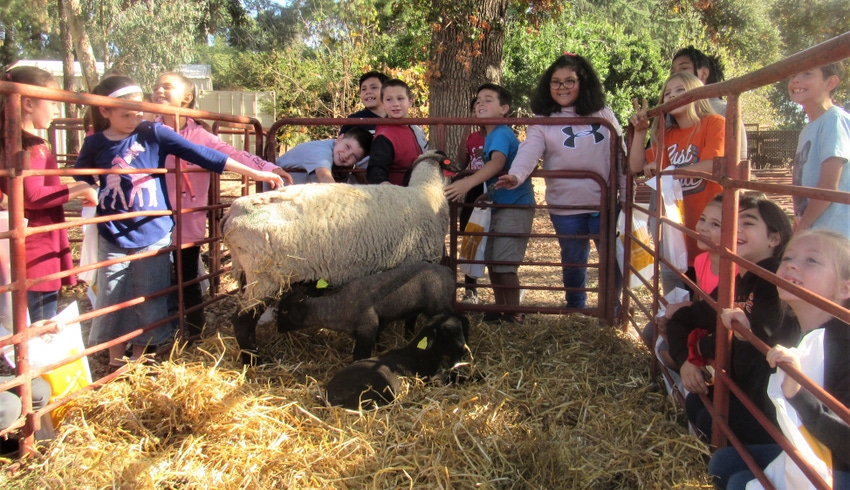
On a recent morning, animal science students Reed Pritchard and Cyanna Iniguez had the most popular stop for third-graders visiting the California State University-Chico farm.
They provided guidance as, one by one, the children tried their hand at roping dummy calves. Pupils at nearby booths, such as one explaining the importance of water to crops, looked over at the roping display in eager anticipation.
The attraction was one of nine stations visited by nearly 600 Northern California schoolchildren on Nov. 7 at the university’s 39th annual kids’ day at the farm, cosponsored by the Butte County Farm Bureau.
“I look forward to it every year,” Sheri Eichan, a teacher at Children’s Community Charter School in Paradise, Calif., said of the farm visit. “This is my favorite field trip. I think it’s great that the farmers open up and welcome the third-graders. They love it.”
The kids’ day capped off a week of activities in the Chico area as part of Farm-City Week, a nationwide movement started in 1955 that is geared to teach city dwellers about the agriculture in their backyard.
“These Farm-City events are great for kids who have no background with production cycles,” said Pritchard, who works on the beef unit at Chico State. “For them to get hands-on with subjects they knew nothing about is very important in a world where knowledge is needed.”
LEARNING STATIONS
In addition to roping, kids visiting the farm got a chance to pet sheep in a pen, examine chicken eggs through a microscope, learn about rice and walnut production in the Sacramento Valley and see a skit by Collegiate FFA students about how the different ingredients of a pizza are produced. At the water display, the children simulated carrying water to Southern California in a lesson about the State Water Project and federal Central Valley Project.
Another popular stop was the beef barn, where the youngsters “milked” a fiberglass cow as they learned about California’s dairy industry.
“My mom will only get California milk,” said third-grader Amelia Tucker, who attends Helen Wilcox Elementary School in Oroville, Calif.
Farm-City Week this year was officially set for Nov. 20-27, but community events were being held throughout November. Myriad locally organized banquets, civic club meetings, farm tours, job exchanges, and other events are geared to recognize partnerships between rural and urban communities that make food safe and plentiful, according to organizers.
WEEK OF ACTIVITIES
Chico’s week of activities began Nov. 2 with the 15th annual harvest festival at the Bidwell Mansion State Historic Park, which included interactive animal displays, simulated calf roping, antique and modern farm equipment, butter churning, nutrition and bee information, a plant sale and horse-drawn carriage rides.
Then on Nov. 6, about 250 local businesspeople and retirees piled into buses at the Chico State farm and took a tour of area agricultural operations, including an almond producer, a winery and a producer of sun-dried tomatoes.
“We have people who come back every year,” said tour organizer Joan Webster, of the California Women for Agriculture. “We never go to the same places.”
Kasey DeAtley, an animal science instructor at Chico State who advises the Young Cattlemen’s Association, recalls talking to third-graders as a college student during the Farm-City field trip 15 years ago. She graduated from Chico State in 2005 later received her master’s and doctoral degrees in animal science at New Mexico State University. Her family owns a cow-calf operation in McArthur, Calif.
“It’s really important because less than 2 percent of the population is directly involved in agriculture,” DeAtley said of Farm-City Week. “A large percentage of the general population doesn’t have a good connection to where their food comes from and how it is produced. It’s a good way to educate the general public about the really good cultural practices as producers.”
About the Author(s)
You May Also Like






